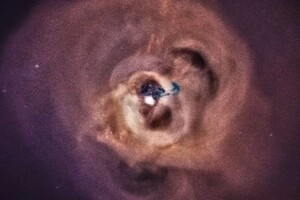The object is at a distance of 250 million light years from Earth.

NASA published an audio recording with the sounds of a supermassive black hole, which is 250 million light years from Earth. The object is located in the center of the Perseus galaxy cluster, the acoustic waves originating from it were shifted 57 and 58 octaves up so that the human ear could catch them, reports Science alert.
As the publication emphasizes, the fact that we do not hear the sounds of space does not mean that they do not exist. In 2003, astronomers discovered something truly amazing: acoustic waves propagating through the abundant volumes of gas surrounding the supermassive black hole at the center of the Perseus cluster. Now it has become famous for its eerie sounds.
Also read: Astronomers discover a 'sleeping' black hole outside the Milky Way
But we wouldn't be able to hear them if we were close to the black hole . Among the sounds and the lowest note ever recorded by scientists, it is far below the limit that the human ear can detect.
Sound processing carried out by NASA specialists raised the audio recording by several octaves, and also added notes recorded in the black hole. This allows us to hear it.
The lowest note recorded as recently as 2003 is B flat, just over 57 octaves below middle C; its frequency is 10 million years. The lowest note that a human can hear has a frequency of one twentieth of a second.
The resulting sounds are not just an answer to the curiosity of scientists. The rarefied gas and plasma that drifts between galaxies in clusters is much denser and hotter than the intergalactic medium. Sound waves propagating through the medium inside the clusters are one of the mechanisms for heating this medium, as they transfer energy through the plasma.
Since temperature can regulate the rate of star formation, sound waves can play a crucial role in the evolution of galaxy clusters over long periods of time. time periods.
This allows scientists to find sound waves. Since the intracluster medium is very hot, it glows brightly in X-ray light.
Related video




